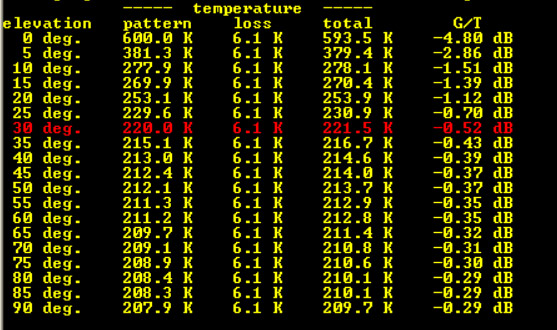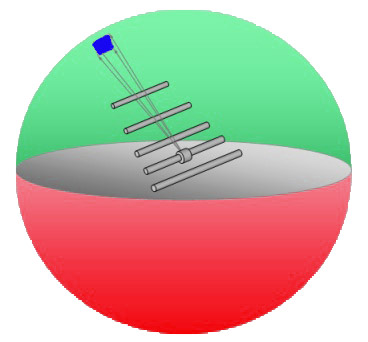Instead of the conventional means of DB gain or DBI gain , a new G/T table has appeared and copied across websites. At first glance this "table" seems very intimidating to the antenna shopper.
However its not really that much different then looking at accurate ( not manufacturers ) DB gain tables.
So what is this all about? Well first there is a concept called Antenna Temperture. Again this is a Concept. Basically the Earth and Atmosphere create a noisy environment around your antenna.
Everything makes noise, The Sun, The Moon, The Sky itself, The Earth, as well as a myriad of Man-Made noises. (Led lights, Plasma TV's, Washing Machines, CATV, etc, etc.) Most unaccountable for.
So Antenna Temperture is not the Physical Temperture of your antenna, it is a relative idea of the amount of noise your antenna will hear. Or better yet a rough guide to the Signal to Noise ratio.
VHF/ UHF experimenters with antennas noticed that at those frequencys, antenna design can be optimized to provide a lower Antenna Temperture or theoretical lower Noise Floor.
Since alot of this work was done by weak signal EME guys who would have their antennas pointed up at the sky, various angles were considered for rating the Antenna Temperture.
The somewhat majority consensus that they came up was 30 degrees of elevation would be fine for rating antennas. This is by no means a solid consensus, But basically an angle had to be picked , so this one got the nod.
Antenna Temperture is rated in kelvin degrees. I am not a fan of this, since many amateurs assume that these ratings coincide with actual tempertures at the antenna.
But Hey I didn't come up with this concept in the first place.
If you are really interested in the details you can have a look here: HERE This dates from 2012.

The G/T System is a measure equal to Signal/Noise ratio at the speakers of our radio. The Antenna is first thing in the Receiving chain. Next would be the Coax and any connections before your Rig,
as these have loss, and in fact sometimes contribute to increased noise. Adding to the confusion about this table is there is also "internal noise". The noise generated by the antenna itself ! So what you want to look for
basically is this the lower the total K number (kelvin degrees) the better, and the G/T column is just the normal db gain of the antenna divided by the antenna temperture. The higher that number the better. Its all about finding your best ham radio antenna
The more bang for the buck so to speak.
So what about the Antennas? How different are they?
The Yagi or Cubical Quad antenna is effective at lowering the noise floor on any frequency, by having most of its radiation manipulated to one direction, and hopefully into one lobe.
This mean cancelling all lobes except those in the main direction the antenna is pointed at, to achieve the lowest noise possible. That also means side lobes, back lobes, lobes at higher elevations, etc.
How does this differ then just DB gain?? In earlier commercially made antennas, the biggest concern was forward DB gain, without regard to whether their might be a weird 9 db gain side lobe
hanging off the back corner of the antenna. Most earlier antenna designs had all kinds of stray lobes, some good front to back ratio, some poor front to back ratios. It didn't really matter.
I mean most people just look at DB gain, and know nothing else on how to rate an antenna, even if that figure itself is terribly inaccurate, that's just
all they know. So for the commercial antenna manufacturer the only number that mattered is / was.......DB GAIN.
So now clever amateur radio operators in the weak signal arena, have come up with better ways to design antennas that have good gain as well as low noise. After all you have heard of the Ham Radio Saying:
"If I can hear em' I can work em" . Well until a few years ago no one paid much attention to hearing them, or at least how to hear em' better. Most of the advances occur in the UHF world first in amateur radio because those antennas can be built and put up on air, within hours from start to finish. So testing results from dozens of antennas can be done in just days or weeks! Where as on HF putting up one 3 or 4 element yagi once in a lifetime is usually the norm. So VHF/UHF guys can find out results through different designs much faster then the HF crowd. However all antennas are scaleable by nature, so if you design a 4 element hi-tech Yagi on 2 meters with 12 DB gain, it translates directly into a 12DB gain 4 element Yagi on 20 meters. Just alot bigger. So anything design advances done on 2 meters or above are completely valid on the HF bands.
So "Low Noise" Yagi's and Quads that you may start hearing about soon in advertisements, are just newer designed antennas taking advantage of recent computer design , which can predict with decent accuracy
how an antenna might perform in the real world. So how much better are these antennas?? Well on HF, certainly the lower the noise figure the better. On the higher UHF frequencys these differences in Antenna Temperture
can mean a difference of 10 or 20 db gain of
lower overall noise. Thats alot. A real lot and critical on the 432 mhz
band.
Remember that old saying "The Cubical Quad hears better and has less noise then the Yagi". Well interesting enough those 100's of reports by Cubical Quad owners were not incorrect! The Weak Signal crowd has confirmed in that attempting to produce the quietest antennas they can, the Loop Fed Yagi and the Cubical Quad in fact DO have lower noise figures then conventional built Yagis! There is a point however in the UHF world where
building a 20 element Yagi on a 20 foot boom is alot easier , simpler and lighter then building a 20 element cubical quad. So there is a trade-off you have to make in Gain, Noise and complexity versus simple to build Yagi's.
However on the HF bands where commonly 3 to 5 element beam antennas are used, the Cubical Quads reputation as the better performer was not a misnomer, but in fact , it is now confirmed through the latest computer software.
Remember that old saying "The Cubical Quad hears better and has less noise then the Yagi". Well interesting enough those 100's of reports by Cubical Quad owners were not incorrect! The Weak Signal crowd has confirmed in that attempting to produce the quietest antennas they can, the Loop Fed Yagi and the Cubical Quad in fact DO have lower noise figures then conventional built Yagis! There is a point however in the UHF world where
building a 20 element Yagi on a 20 foot boom is alot easier , simpler and lighter then building a 20 element cubical quad. So there is a trade-off you have to make in Gain, Noise and complexity versus simple to build Yagi's.
However on the HF bands where commonly 3 to 5 element beam antennas are used, the Cubical Quads reputation as the better performer was not a misnomer, but in fact , it is now confirmed through the latest computer software.
The
Bottom Line is this:
The newer "Low Noise" Yagis and Cubical Quad antennas now just being produced commercially pick up less noise.
This means more signal for you. Or in G/T terms: a lower noise temperture.
The newer "Low Noise" Yagis and Cubical Quad antennas now just being produced commercially pick up less noise.
This means more signal for you. Or in G/T terms: a lower noise temperture.










